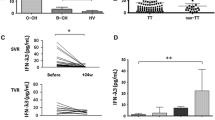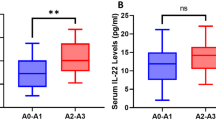Abstract
The present study evaluated the plausible role of circulating biomarkers in immune pathogenesis of chronic hepatitis considered a priority in clinical hepatology. Total viral load of chronic hepatitis B virus (HBV) and hepatitis C virus (HCV) patients was quantified and correlation studies were performed with circulating levels of Th1/Th2 cytokines; C reactive protein and circulating nucleosomes; glutathione reductase (GR) and superoxide dismutase. To our knowledge, the study is first among its kind that validates strong positive correlation of viral load with IL-4, IL-6, GR in HBV and IL-6, IL-10, GR in HCV infections. Although, multi-centric studies including large cohorts are required for translating our findings to clinical practice, however, role of these biomarkers with potential diagnostic or prognostic significance might be helpful in clinical assessment of high-risk individuals, thereby, designing interventional strategies, towards development of personalized medicare. The results of our study also offer valuable insights of immune signaling mediators engaged in development of hepatocellular carcinoma.


Similar content being viewed by others
References
Hepatitis B. Vaccines. Wkly Epidemiol Rec. 2004;9:255–63.
Shepard CW, Simard EP, Finelli L, Fiore AE, Bell BP. Hepatitis B virus infection: epidemiology and vaccination. Epidemiol Rev. 2006;28:112–25.
Alter MJ. Epidemiology of hepatitis C virus infection. World J Gastroenterol. 2007;13:2436–41.
Modlin RL, Nutman TB. Type 2 cytokines and negative immune regulation in human infections. Curr Opin Immunol. 1993;5:511–4.
NIH Consensus Statement on Management of Hepatitis C. NIH Consens State Sci Statements. 2002;19:1–46.
Hultgren C, Milich DR, Weiland O, Sallberg M. The antiviral compound ribavirin modulates the T helper (Th) 1/Th2 subset balance in hepatitis B and C virus-specific immune responses. J Gen Virol. 1998;10:2381–91.
Fan XG, Liu WE, Li CZ, Wang ZC, Luo LX, Tan DM, et al. Circulating Th1 and Th2 cytokines in patients with hepatitis C virus infection. Mediators Inflamm. 1998;7:295–7.
Ramadori G, Armbrust T. Cytokines in the liver. Eur J Gastroenterol Hepatol. 2001;13:777–84.
Moriya K, Nakagawa K, Santa T, Shintani Y, Fujie H, Miyoshi H, et al. Oxidative stress in the absence of inflammation in a mouse model for hepatitis C virus-associated hepatocarcinogenesis. Cancer Res. 2001;61:4365–70.
Hoek JB, Pastorino JG. Ethanol, oxidative stress, and cytokine-induced liver cell injury. Alcohol. 2002;27:63–8.
Farinati F, Cardin R, Degan P, De Maria N, Floyd RA, Van Thiel DH, et al. Oxidative DNA damage in circulating leukocytes occurs as an early event in chronic HCV infection. Free Radic Biol Med. 1999;27:1284–91.
Chen CJ, Yang HI, Su J, Jen CL, You SL, Lu SN, et al. Risk of hepatocellular carcinoma across a biological gradient of serum hepatitis B virus DNA level. JAMA. 2006;295:65–73.
Mishra PK, Bhargava A, Khan S, Pathak N, Punde RP, Varshney S. Prevalence of hepatitis C virus genotypes and impact of T helper cytokines in achieving sustained virological response during combination therapy: a study from Central India. Indian J Med Microbiol. 2010;28:358–62.
Mishra PK, Khan S, Bhargava A, Panwar H, Banerjee S, Jain SK, et al. Regulation of isocyanate-induced apoptosis, oxidative stress, and inflammation in cultured human neutrophils: isocyanate-induced neutrophils apoptosis. Cell Biol Toxicol. 2010;26:279–91.
Mishra PK, Raghuram GV, Panwar H, Jain D, Pandey H, Maudar KK. Mitochondrial oxidative stress elicits chromosomal instability after exposure to isocyanates in human kidney epithelial cells. Free Radic Res. 2009;43:718–28.
Bhargava A, Punde RP, Pathak N, Dabadghao S, Desikan P, Jain A, et al. Status of inflammatory biomarkers in the population that survived the Bhopal gas tragedy: a study after two decades. Ind Health. 2010;48:204–8.
Bhargava A, Khan S, Panwar H, Pathak N, Punde RP, Varshney S, et al. Occult hepatitis B virus infection with low viremia induces DNA damage, apoptosis and oxidative stress in peripheral blood lymphocytes. Virus Res. 2010;153:143–50.
Mishra PK, Dabadghao S, Modi GK, Desikan P, Jain A, Mittra I, et al. In utero exposure to methyl isocyanate in the Bhopal gas disaster: evidence of persisting hyperactivation of immune system two decades later. Occup Environ Med. 2009;66:279.
Alacacioglu A, Somali I, Simsek I, Astarcioglu I, Ozkan M, Camci C, et al. Epidemiology and survival of hepatocellular carcinoma in Turkey: outcome of multicenter study. Jpn J Clin Oncol. 2008;38:683–8.
Fan XG, Yakkob J, Fan XJ, Keeling PW. Enhanced Th2 responses: immune mechanism of H. pylori infection. Ir J Med Sci. 1996;165:37–9.
Jirillo E, Greco B, Caradonna L, Satalino R, Pugliese V, Cozzolongo R, et al. Evaluation of cellular immune responses and soluble mediators in patients with chronic hepatitis C virus (cHCV) infection. Immunopharmacol Immunotoxicol. 1995;17:347–64.
Cacciarelli TV, Martinez OM, Gish RG, Villanueva JC, Krams SM. Immunoregulatory cytokines in chronic hepatitis C virus infection: pre-and post treatment with interferon alfa. Hepatology. 1996;24:6–9.
Piazzolla G, Tortorella C, Schiraldi O, Antonaci S. Relationship between interferon-gamma, interleukin-10, and interleukin-12 production in chronic hepatitis C and in vitro effects of interferon-alpha. J Clin Immunol. 2000;20:54–61.
Song LH, Binh VQ, Dinh ND, Kun JF, Bock TC, Kremsner PG, et al. Serum cytokine profiles associated with clinical presentation in Vietnamese infected with hepatitis B virus. J Clin Virol. 2003;28:93–103.
Clerici M, Shearer GM. TH1-TH2 switch is a critical step in the etiology of HIV infection. Immunol Today. 1993;14:107–10.
Hsia CY, Huo TI, Chiang SY, Lu MF, Sun CL, Wu JC, et al. Evaluation of interleukin-6, interleukin-10 and human hepatocyte growth factor as tumor markers for hepatocellular carcinoma. Eur J Surg Oncol. 2007;33:208–12.
Pepys MB, Hirschfield GM. C-reactive protein: a critical update. J Clin Invest. 2003;111:1805–12.
Shrive AK, Cheetham GM, Holden D, Myles DA, Turnell WG, Volanakis JE, et al. Three dimensional structure of human C-reactive protein. Nat Struct Biol. 1996;3:346–54.
Frank R, Hargreaves R. Clinical biomarkers in drug discovery and development. Nat Rev Drug Discov. 2003;2:566–80.
Black S, Kushner I, Samols D. C-reactive protein. J Biol Chem. 2004;279:48487–90.
Clearfield MB. C-reactive protein: a new risk assessment tool for cardiovascular disease. J Am Osteopath Assoc. 2005;105:409–16.
Di Napoli M, Papa F. C-reactive protein and cerebral small-vessel disease: an opportunity to reassess small-vessel disease physiopathology? Circulation. 2005;112:781–5.
Lin ZY, Wang LY, Yu ML, Chen SC, Chuang WL, Hsieh MY, et al. Role of serum C-reactive protein as a marker of hepatocellular carcinoma in patients with cirrhosis. J Gastroenterol Hepatol. 2000;15:417–21.
Nagaoka S, Yoshida T, Akiyoshi J, Akiba J, Torimura T, Adachi H, et al. Serum C-reactive protein levels predict survival in hepatocellular carcinoma. Liver Int. 2007;27:1091–7.
Patel T. Apoptosis in hepatic pathophysiology. Clin Liver Dis. 2000;4:295–317.
Liu DX. A new hypothesis of pathogenetic mechanism of viral hepatitis B and C. Med Hypotheses. 2001;56:405–8.
Holdenrieder S, Eichhorn P, Beuers U, Samtleben W, Schoenermarck U, Zachoval R, et al. Nucleosomal DNA fragments in autoimmune diseases. Ann N Y Acad Sci. 2006;1075:318–27.
Swietek K, Juszczyk JJ. Reduced glutathione concentration in erythrocytes of patients with acute and chronic viral hepatitis. J Viral Hepat. 1997;4:139–41.
Halliwell B, Gutteridge JMC. Free radicals in biology and medicine. 3rd ed. Oxford: Science Publications; 1999.
Chrobot AM, Szaflarska-Szczepanik A, Drewa G. Antioxidant defense in children with chronic viral hepatitis B and C. Med Sci Monit. 2000;6:713–8.
Tanyalcin T, Taskiran D, Topalak O, Batur Y, Kutay F. The effects of chronic hepatitis C and B virus infections on liver reduced and oxidized glutathione concentrations. Hepatol Res. 2000;18:104–9.
Demirdag K, Yilmaz S, Ozdarendeli A, Ozden M, Kalkan A, Kilic SS. Levels of plasma malondialdehyde and erythrocyte antioxidant enzyme activities in patients with chronic hepatitis B. Hepatogastroenterology. 2003;50:766–70.
Maki A, Kono H, Gupta M, Asakawa M, Suzuki T, Matsuda M, et al. Predictive power of biomarkers of oxidative stress and inflammation in patients with hepatitis C virus-associated hepatocellular carcinoma. Ann Surg Oncol. 2007;14:1182–90.
Acknowledgment
The authors gratefully acknowledge financial support of the Bhopal Memorial Hospital Trust, India.
Author information
Authors and Affiliations
Corresponding author
Rights and permissions
About this article
Cite this article
Khan, S., Bhargava, A., Pathak, N. et al. Circulating Biomarkers and their Possible Role in Pathogenesis of Chronic Hepatitis B and C Viral Infections. Ind J Clin Biochem 26, 161–168 (2011). https://doi.org/10.1007/s12291-010-0098-7
Received:
Accepted:
Published:
Issue Date:
DOI: https://doi.org/10.1007/s12291-010-0098-7




